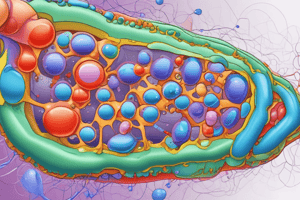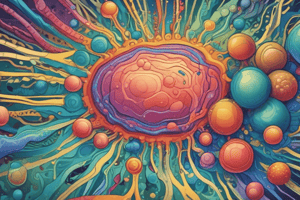Podcast
Questions and Answers
What is the main function of the plasma membrane?
What is the main function of the plasma membrane?
- To synthesize proteins
- To store genetic information
- To generate energy for the cell
- To regulate what enters and leaves the cell (correct)
What type of molecules are membrane lipids?
What type of molecules are membrane lipids?
- Electrolytic
- Amphipathic (correct)
- Hydrophobic
- Hydrophilic
What holds the lipid bilayer together?
What holds the lipid bilayer together?
- Hydrophobic effect and weak Van der Waals forces (correct)
- Hydrogen bonds
- Covalent bonds
- Ionic bonds
What is the function of phospholipids in the membrane?
What is the function of phospholipids in the membrane?
What type of proteins are embedded in the plasma membrane?
What type of proteins are embedded in the plasma membrane?
What is the unique characteristic of membranes due to their lipid bilayer structure?
What is the unique characteristic of membranes due to their lipid bilayer structure?
What is the type of lipid found in all membranes except the inner mitochondrial membrane?
What is the type of lipid found in all membranes except the inner mitochondrial membrane?
What is the function of Golgi apparatus in the cell?
What is the function of Golgi apparatus in the cell?
Where does fatty acid metabolism (degradation) occur?
Where does fatty acid metabolism (degradation) occur?
What is the function of the mitochondrial DNA (mtDNA)?
What is the function of the mitochondrial DNA (mtDNA)?
What is the main function of the Citric Acid Cycle (Krebs Cycle)?
What is the main function of the Citric Acid Cycle (Krebs Cycle)?
What is the function of the Rough Endoplasmic Reticulum (RER)?
What is the function of the Rough Endoplasmic Reticulum (RER)?
What is the function of the Smooth Endoplasmic Reticulum (SER)?
What is the function of the Smooth Endoplasmic Reticulum (SER)?
What is the function of biotransformation in the Smooth Endoplasmic Reticulum (SER)?
What is the function of biotransformation in the Smooth Endoplasmic Reticulum (SER)?
What is the function of the Smooth Endoplasmic Reticulum (SER) in muscle cells?
What is the function of the Smooth Endoplasmic Reticulum (SER) in muscle cells?
What is the site of Oxidative Phosphorylation reactions?
What is the site of Oxidative Phosphorylation reactions?
What is the main function of proteins in the plasma membrane?
What is the main function of proteins in the plasma membrane?
Which metabolic pathway takes place in the cytoplasm of the cell?
Which metabolic pathway takes place in the cytoplasm of the cell?
What is the main function of the cytoskeleton in the cell?
What is the main function of the cytoskeleton in the cell?
What is the function of the outer membrane of the mitochondria?
What is the function of the outer membrane of the mitochondria?
What is the function of microtubules in the cytoskeleton?
What is the function of microtubules in the cytoskeleton?
What is the function of proteins on the surface of immune cells?
What is the function of proteins on the surface of immune cells?
What is the function of the matrix in the mitochondria?
What is the function of the matrix in the mitochondria?
What is the fluid-mosaic model of the plasma membrane?
What is the fluid-mosaic model of the plasma membrane?
What is the function of the ribosomes?
What is the function of the ribosomes?
Where are the newly synthesized proteins folded into their functional shape?
Where are the newly synthesized proteins folded into their functional shape?
What is the main function of the Golgi apparatus?
What is the main function of the Golgi apparatus?
What factors determine the number and distribution of ribosomes in a cell?
What factors determine the number and distribution of ribosomes in a cell?
What type of cells have a large number of ribosomes?
What type of cells have a large number of ribosomes?
What is the function of the ribosomal subunits?
What is the function of the ribosomal subunits?
What is the location of the Golgi apparatus?
What is the location of the Golgi apparatus?
What are hydrolytic enzymes made in and then transferred to the Golgi for further processing?
What are hydrolytic enzymes made in and then transferred to the Golgi for further processing?
What is the primary function of lysosomes in a cell?
What is the primary function of lysosomes in a cell?
What is the pH of the lysosome's contents?
What is the pH of the lysosome's contents?
What is the function of the ATP-driven V-type proton pump in lysosomes?
What is the function of the ATP-driven V-type proton pump in lysosomes?
What is the term for the process by which cells recycle their own damaged cell parts?
What is the term for the process by which cells recycle their own damaged cell parts?
What is the primary function of peroxisomes?
What is the primary function of peroxisomes?
What are the reactive oxygen species (ROS) produced by peroxisomes?
What are the reactive oxygen species (ROS) produced by peroxisomes?
What is the function of acid phosphatase in lysosomes?
What is the function of acid phosphatase in lysosomes?
What is the term for the process by which white blood cells engulf and destroy foreign substances?
What is the term for the process by which white blood cells engulf and destroy foreign substances?
Flashcards are hidden until you start studying
Study Notes
Plasma Membrane
- Proteins are responsible for most of the functions of the membrane and are mobile within it, describing the membrane as a fluid-mosaic model.
- Biochemical functions of the plasma membrane:
- Energy conversion processes such as oxidative phosphorylation
- Regulation of molecular and ionic composition of cell compartments through pumps and channels
- Control of genetic information flow between cells
- Production and reception of chemical signals
- Consists of important enzymes that catalyze reactions such as lipid biosynthesis and xenobiotic metabolism
Cytoplasm
- Important cellular compartment and central reaction space of the cell
- Many important pathways of metabolism take place in the cytoplasm, including:
- Glycolysis
- Pentose phosphate pathway
- Gluconeogenesis
- Fatty acid synthesis
- Protein biosynthesis (translation)
- Glycogenesis (glycogen synthesis) and glycogenolysis (glycogen degradation)
- Consists of a supportive network of proteinaceous fibers and filaments called the cytoskeleton
- Functions of the cytoskeleton:
- Maintaining each cell's shape
- Facilitating cell movements
- Guiding the movement of organelles within the cell
- Components of the cytoskeleton:
- Microtubules (found in axons and dendrites of nerve cells)
- Microfilaments (found in protein actin in muscle)
- Intermediate fibers (found in protein keratin in skin)
Mitochondria
- Sausage-shaped structure bounded by two membranes: outer membrane (smooth and permeable to most molecules) and inner membrane (impermeable to ions and other molecules)
- Functions:
- Fatty acid metabolism (degradation) occurs in the matrix
- Oxidative phosphorylation reactions occur, producing energy as ATP in the presence of O2
- Citric acid cycle (Krebs cycle) occurs in the mitochondria, oxidizing amino acids, fatty acids, and carbohydrates
- Mitochondria has its own protein synthesizing apparatus, including DNA (mtDNA), ribosomes, tRNA, and mRNA, and plays a role in its own replication (DNA synthesis)
Endoplasmic Reticulum (E-R)
- System of interconnected membranous tubules
- Two forms of E-R:
- Rough E-R: involved in the synthesis of proteins for membrane and exporting it from the cell, with ribosomes attached to it
- Smooth E-R: functions in lipid synthesis, calcium storage, and biotransformation (converting lipid-soluble molecules to water-soluble and excreting them)
Ribosomes
- Small organelles that function in the biosynthesis of proteins
- Complex structure containing two irregularly shaped subunits of unequal size
- Number and distribution of ribosomes depend on:
- Metabolic activity
- Type of protein synthesized
- Cells with high rates of protein synthesis have larger numbers of ribosomes
Golgi Apparatus
- Flattened sac-like membranous vesicles located near the nucleus and close to the E-R and plasma membrane
- Functions:
- Packaging and secretion of cell products such as newly synthesized proteins and lipids
- Modifying products of ER like glycoproteins and membrane phospholipids
- Manufacturing macromolecules such as polysaccharides
Lysosomes
- Small sac-like organelles produced in E-R and Golgi apparatus
- Functions:
- Breaking down cell components either micro or macromolecules by digestive enzymes
- Digesting cell organelles
- Autophagy: recycling the cell's own organic material
Peroxisomes
- Small spherical membranous organelles that contain oxidative enzymes
- Functions:
- Generating and breaking down toxic molecules such as reactive oxygen species (ROS)
- Removing H+ atoms from substrates to oxygen, producing H2O2 (hydrogen peroxide)
Studying That Suits You
Use AI to generate personalized quizzes and flashcards to suit your learning preferences.





